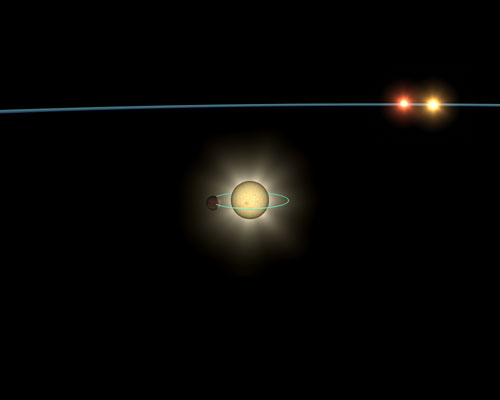
Warm Distant Moons
Many years ago the late Dr Carl Sagan wrote about comets and expressed the idea that humans might one day be able to hitch a ride on one to travel across the galaxy (1). This is because comets don't just occur in belts and clouds surrounding the Sun, but can also be found traversing the vast space between stars. Comets in the outer regions of the Solar System, known as the outer Oort Cloud, are loosely bound and can sometimes be tugged away from the Sun's weak grasp to begin an eternal journey across interstellar space. Should the technology one day arise whereby comets could be hollowed out and inhabited, then small populations of humans could use these comets to travel across the galaxy.

Such fantastic thoughts are typical of Carl Sagan, who knew well how to bring the wonders of Science to normal people. His popular re-formulation of science became an art-form in some ways, embracing the speculation of science fiction. Unfortunately, such an ability to broaden science's appeal is generally lacking in the more entrenched and conservative mindset of present day scientists.
Ironically, Nature herself has come to the rescue in the field of Planetary Science. In the last few years She has provided stories of wonder so fantastic that they are almost impervious to the dull, jargon-ridden mumblings of the scientists charged with their investigation. For example, the menagerie of incredible giant worlds discovered by extra-solar planet researchers has forced scientists to re-think their dearest assumptions regarding the formation of planetary systems around stars.
Recently, a planet which falls into the relatively new category of 'hot Jupiter'-type world was discovered pinning dizzily around a star whose planetary retinue also includes a couple of other stars! (2) This kind of discovery is hardly even a headline these days, but only a few years ago the merely though of such a system forming would have been written off as the most outlandish science fiction.
Not only is there a huge issue about how a gas giant could be found so close to its parent star, apparently enjoying a comfortable lifestyle against all the odds, but how did such a planet form when subject to the complex gravitational interactions of this compact triple star system? It is a mystery, one which has implications for our considerations of the diversity of planetary systems out there. Like life, planets seem to be able to survive just about anywhere.
Habitable Worlds among the Comets
The hollowed-out body of a comet is a solution that many fans of Zecharia Sitchin have proposed to explain the problem of Nibiru. This subject recently came up in correspondence with Sitchin's webmaster Erik Parker (3). He is unconvinced that the inhospitable climate of a comet world's surface in deep space presents difficulties for the "12th Planet Theory". In short, at the low end of the temperature spectrum planets would find their atmospheres literally freeze out onto their surfaces as ice. If you shunted the Earth to a position beyond the outer planets then the beautiful blue skies of this world would quickly fall to Earth, covering the entire surface of our world with nitrogen and oxygen ices at depths measuring in the metres. If you then stood on the ice and looked up during daytime, you would see the Sun closeted within the blackness of space. This same fate holds for all terrestrial planets among the comets, including Sitchin's Nibiru.
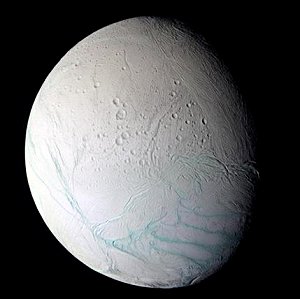
Yet, Nibiru is understood to have an atmosphere, one that is at threat of destruction, it seems. Even if the denizens of Nibiru, known as the Anunnaki, escaped the frigid surface of their ice-covered world to live under the surface, then we still cannot square the circle of Nibiru's fabulous atmosphere. There shouldn't be an atmosphere; it should be 'destroyed' as soon as Nibiru moves beyond the outer planets!
There are only two solutions to this conundrum. The first is that Sitchin's theory is just wrong. The second is that this habitable planet is warmed by a much larger planet in close proximity to it. In other words, the home-world of the Anunnaki orbits a gas giant-like planet beyond Pluto. Such a massive world would have to be at a considerable distance to have evaded detection, and is likely to be a sub-brown dwarf. I call this planet the 'Dark Star'.
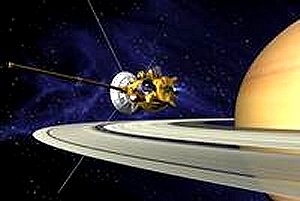
Recently, the Cassini spacecraft provided us with further evidence to support such ideas. Cassini is exploring the system of moons orbiting distant Saturn, and its instruments recorded anomalous temperatures at the south pole of one of the minor moons called Enceladus (4). Now, we already now that an atmosphere can be maintained on a Saturnian moon, because Titan has a rich, opaque atmosphere of hydrocarbons.
But Titan is, as its name suggests, a rather large moon; more of a planet really. The Sun's heat can still be a factor even at Saturn's great distance, but the tidal effect of the ringed planet is a major factor to help maintain Titan's global warming.
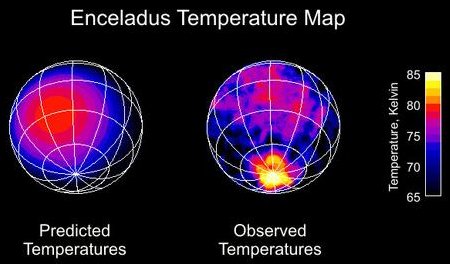
However, Enceladus is a small moon whose diameter is a mere 500 kilometres across. Yet, it is producing a water-rich atmosphere to compliment its ice-covered surface. The origin of the water vapour seeping out onto its surface appears to be through a volcanic system within Enceladus. I would say 'deep within Enceladus', but herein lies the problem.
It is really not that big a lump of rock! It shouldn't be generating the kind of heat internally that could stir volcanic activity into action. Yet, here it is, pumping out gas in such volumes that the escaping water vapour is creating one of Saturn's rings. The rest settles onto Enceladus' brilliant surface:
"The ion and neutral mass spectrometer and the ultraviolet imaging spectrograph found the atmosphere contains water vapor. The mass spectrometer found the water vapor comprises about 65 percent of the atmosphere, with molecular hydrogen at about 20 percent. The rest is mostly carbon dioxide and some combination of molecular nitrogen and carbon monoxide. The variation of water vapor density with altitude suggests the water vapor may come from a localized source comparable to a geothermal hot spot. The ultraviolet results strongly suggest a local vapor cloud." (4)
The Galilean moons of Jupiter
As a result, Enceladus is compared to the Galilean moons of Jupiter which also exhibit young surfaces dominated by reconditioned ices. Europa has a billiard-ball like surface of ice covering a planet-wide ocean within. Ganymede and Callisto are similarly endowed with watery underworlds.
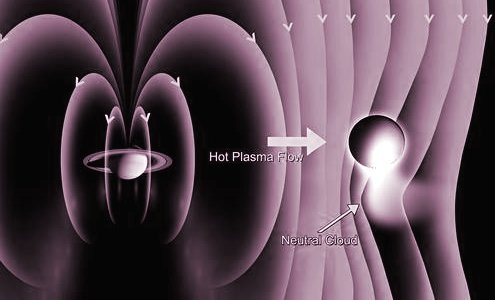
The fourth major moon, Io, is so close to Jupiter's gravitational pull that its internal heating is way out of control. Io regularly pumps out lava onto its pock-marked surface, and is the most volcanic real estate in the Solar System. Now, it seems, Io has some competition in the form of little Enceladus. This tiny world appears to be one big orbiting volcano!
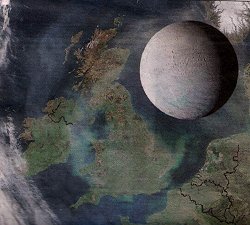
This amazing little discovery serves to illustrate how great the effect can be of tidal forces and the emission of hot plasma from gas giants. Imagine that effect magnified by the considerably greater gravity of a sun-brown dwarf. It seems clear to me that a Dark Star beyond the Edgeworth-Kuiper Belt could readily create the conditions for life on one or more of its own attendant planets. At these distances, the heat of the Sun would be negligible.
Normal comets at these distances are just frozen lumps of rock and ice. As would any 'tenth planet'. But if you place a Dark Star at this position, then, like an oasis in the desert, the potential for habitable conditions grows exponentially. There is no longer the need to hollow out comets to live in. An Earth-like world could very easily be found orbiting a Dark Star in the Solar System.
Liquid Water on Enceladus
The Cassini mission continues to throw up surprises in the Saturnian system of moons. The fact that tidal forces are heating up part of the moon Enceladus was remarkable enough. Now it appears that the moon is also spewing out jets of liquid water from its interior (5).
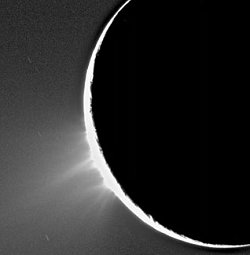
This incredible little world is suddenly one of the best potential pockets of life in the solar system, joining the Jovian Galilean moons Europa, Callisto and Ganymede. What marks Enceladus apart, however, is that the source of this water may be just below its icy-covered surface. This contrasts with Jupiter's main moons, where oceans of water are thought to lie below ice which is many miles thick.
Enceladus is also a bit like Io, the volcanic sibling of the three icy Galilean moons. It shares common ground with Io because they are both volcanically active. Io seems rather like an extraterrestrial vision of Hell. Enceladus is a more gentle cousin, combining its vulcanism with the pockets of water trapped below its surface. the combination has provided NASA with a glimpse of the moon spewing water into the Saturn system, creating an anomalously high oxygen content in the space around the ringed giant.
All of this makes for a compelling argument about the potential for liquid water around a more distant Dark Star, and thus for the potential for the evolution of life in the vicinity of a dark binary companion.
Zecharia Sitchin's Thoughts
Zecharia Sitchin has recently commented upon this new and remarkable finding about the Saturnian moon Enceladus. His thoughts are worth repeating in full here:
"The assertion that the Anunnaki came from a planet (Nibiru) whose orbit extends far out in our solar system has repeatedly led to the question: How could life exist so far away from the Sun, where it is extremely cold and everything freezes?
"My answer has been that we need not go that far out to freeze to death — just rising above Earth’s surface would do the trick. It is the planet’s atmosphere that retains the warmth — be it warmth obtained from the Sun, or from an internal source of heat. The crucial issue for the Anunnaki, I explained, was to prevent the loss of Nibiru’s atmosphere; they sought to do that with a shield of gold particles, and they came here to obtain the gold.

"Now comes news that made headlines worldwide: WATER GEYSERS ON SATURN MOON HINT LIFE POSSIBILITY.
"The exciting news came from a report in the journal Science (10 March 2006), in which NASA revealed that its Cassini spacecraft discovered that Saturn’s fourth moon, Enceladus, spouts water geysers — “which hints at pockets of liquid water under the surface.” For that the temperature below the surface must be above freezing. In fact, even the moon’s above-surface temperature turned out to be 100 degrees warmer than what had been expected!
"While planets generate internal heat from radioactive materials in their cores, the Saturn moon, it is now theorized, may be warmed by magnetic reactions as it orbits Saturn. One way or another, the astounding discovery corroborates scientifically the information that I have reported based on Sumerian writings: Yes, even that far away from the Sun, it can be hot enough for water to flow and life to emerge!" (6)
I agree with Zecharia that this discovery is both surprising, and helpful to our common speculations. For such a small moon to exhibit the ability to have liquid water is truly remarkable, and breaks apart some commonly held ideas in the field of planetary science. If the reason for this extra heat was an atmosphere I think Zecharia would have reason to be very cheerful indeed. However, this moon is warmed by its geocentric orbit around the gas giant Saturn. Indeed, it is located within one of Saturn's mighty rings. So this heat source is most probably the result of the gravitational and magnetic field relationship between the giant planet and its tiny moon. Without Saturn, the effect would very likely disappear.
Of course, we cannot absolutely rule out the possibility that something really weird is going on here on Enceladus. But it is most likely that this finding more closely corroborates the Dark Star version of the Nibiru scenario: That life emerges on a warmed moon found orbiting a distant small brown dwarf. That's where surface water would be found in deepest space.
Written by Andy Lloyd, 9th August 2005, and updated 13th March & 5th April 2006
author of 'The Dark Star' (2005), 'Ezekiel One' (2009), 'The Followers of Horus' (2010), 'Darker Stars' (2019)
References
1. C. Sagan & A. Druyan "Comet" p350, Headline 1985
2. NASA Press Release "NASA Scientist Finds World With Triple Sunsets" 13 July 2005, with thanks to Monika Myers
3. Correspondence with Erik Parker, June 2005
4. NASA news release "Cassini Finds an Active, Watery World at Saturn's Enceladus" 29 July 2005, with thanks to Monika Myers
5. NASA "Radical! Liquid Water on Enceladus" 9 March 2006, with thanks to the Cosmics
6. Z. Sitchin "Brother, it's hot out there!" With thanks to David Pearson